How To Care For Your Fibreglass Pool
Fibreglass pools are a popular choice for homeowners in Australia due to their durability, low maintenance, and aesthetic appeal. Made from a composite material that combines glass fibres and resin, fibreglass pools offer a smooth surface, energy efficiency, and the ability to retain heat better than concrete or vinyl pools. However, like all pools, fibreglass pools require proper care and maintenance to ensure they remain in top condition for years to come. In this article, we will discuss the key aspects of caring for your fibreglass pool, including cleaning, water quality management, repairs, and seasonal considerations.
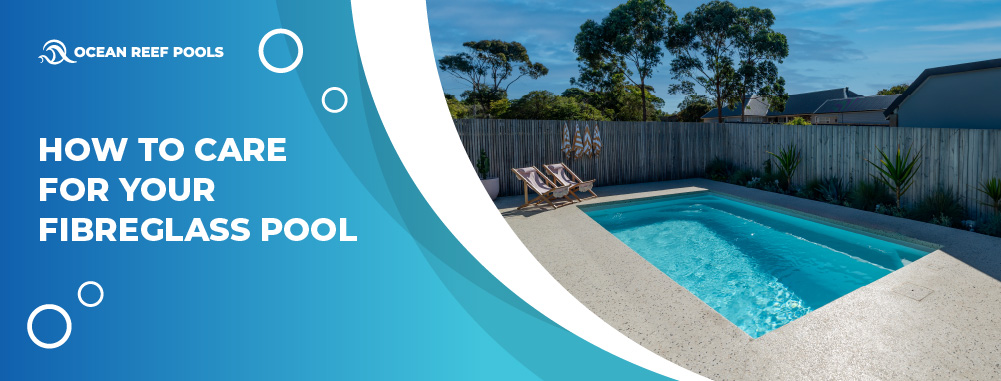
1. Regular Cleaning and Skimming
Cleaning is one of the most basic yet essential aspects of pool maintenance. Debris such as leaves, dirt, and insects can quickly accumulate in your fibreglass pool, affecting both its appearance and water quality. Skimming the pool surface regularly with a net or skimmer is essential for removing debris. It’s best to skim the surface at least once a day during the warmer months when debris tends to fall more frequently.
In addition to skimming, it’s important to clean the pool floor and walls to prevent the build-up of dirt and algae. A pool vacuum is useful for cleaning the floor, and a soft-bristled brush can be used to scrub the pool walls. Fibreglass pools are resistant to algae growth due to their smooth surfaces, but regular brushing can help prevent any potential build-up, especially in areas with warmer climates.
2. Maintaining Water Quality
One of the most critical aspects of pool care is maintaining the water quality. Proper water balance ensures that the pool is safe to swim in and helps extend the life of your fibreglass pool. Water quality is primarily determined by the levels of pH, chlorine, alkalinity, and calcium hardness.
- pH Levels: The pH of the pool water indicates its acidity or alkalinity. Ideally, the pH should be between 7.2 and 7.8. If the pH is too low, the water becomes acidic and can cause corrosion of pool equipment, including the fibreglass shell. If the pH is too high, the water becomes alkaline, which can lead to scaling and cloudy water. Regularly testing and adjusting the pH is vital.
- Chlorine Levels: Chlorine is the most common disinfectant used in pools to kill bacteria, viruses, and algae. The ideal chlorine level in a fibreglass pool should be between 1.5 and 3.0 ppm (parts per million). Too little chlorine can lead to poor water quality, while too much chlorine can cause skin irritation and damage pool equipment. You should regularly test the chlorine levels and add chlorine as needed.
- Alkalinity: Alkalinity acts as a buffer to stabilise pH levels. The recommended range for alkalinity is between 80 and 120 ppm. If alkalinity is too low, the pH levels can fluctuate, making it harder to maintain a consistent water balance. On the other hand, high alkalinity can lead to cloudy water and scaling.
- Calcium Hardness: Calcium hardness refers to the concentration of dissolved calcium in the water. For fibreglass pools, the ideal range is between 200 and 400 ppm. Low calcium hardness can cause the pool surface to etch or degrade over time, while high levels of calcium can cause scaling and cloudy water. Regular testing is crucial to ensure calcium levels are in check.
To test the water quality, you can either use a pool testing kit or take a sample of your pool water to a local pool shop for professional testing. Adjusting the water chemistry may involve adding chemicals such as pH increasers or decreasers, alkalinity buffers, calcium hardness increasers, and chlorine tablets.
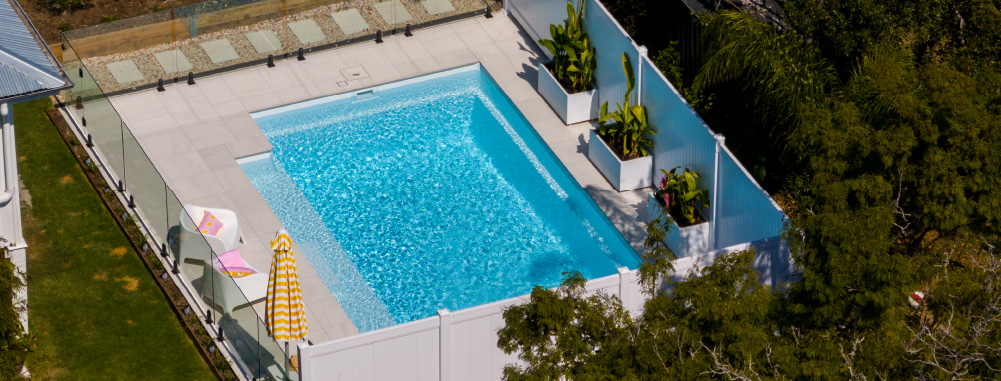
3. Regularly Checking Pool Equipment
Fibreglass pools rely on various equipment to keep the water clean, clear, and safe to swim in. Regular inspection and maintenance of the pool’s equipment are essential to ensure everything is functioning properly.
- Pool Pump and Filter: The pool pump circulates water through the filter, which removes debris and particles from the water. Check the pool pump and filter regularly for any clogs or signs of wear and tear. A clogged filter can reduce water circulation and cause strain on the pump, potentially leading to expensive repairs. Depending on the size of the pool, the filter should be cleaned every few weeks during peak swimming seasons. Be sure to replace the filter as recommended by the manufacturer.
- Saltwater System: If you have a saltwater pool, it’s important to check the salt chlorinator system regularly. Saltwater systems generate chlorine through electrolysis, which keeps the water disinfected. Over time, calcium deposits can build up on the salt cell, reducing its efficiency. Clean the salt cell as per the manufacturer’s instructions to ensure the system is working effectively.
- Pool Heater: If your fibreglass pool has a heating system, ensure that it’s serviced regularly to keep it running efficiently. Pool heaters can wear out over time due to constant use, and regular maintenance will help extend their lifespan.
4. Managing Pool Water Level
The water level in your pool should always be maintained at the correct level. If the water level is too low, the skimmer might run dry, which can cause the pump to burn out. On the other hand, if the water level is too high, debris may not be properly skimmed from the surface, and the pool may become difficult to clean.
During the summer, evaporation can lower the water level, so it’s essential to top up the pool regularly to ensure it remains within the recommended range. If your area experiences a lot of rain, you may need to remove excess water using a submersible pump to avoid overfilling.
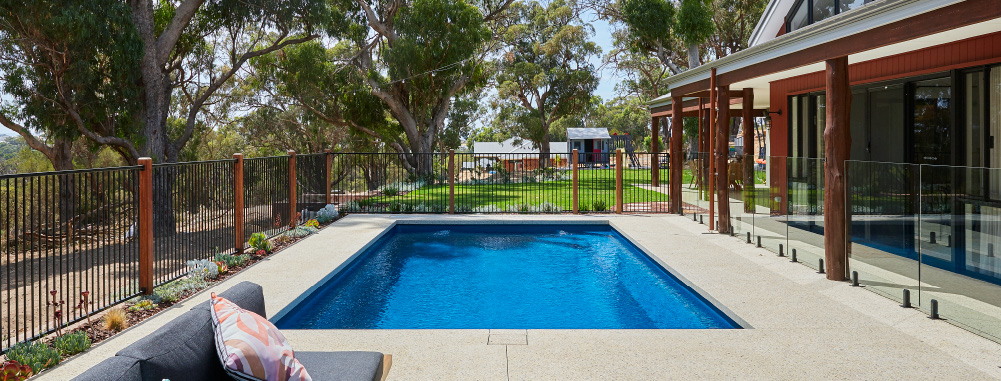
5. Protecting the Pool from the Elements
While fibreglass pools are durable and weather-resistant, extreme weather conditions can still affect their appearance and functionality. Protecting your pool from harsh elements is crucial for maintaining its longevity.
- Sun Exposure: Excessive exposure to the sun can cause the pool water to heat up, which can lead to algae growth and increase the need for chemicals. Consider installing a pool cover or shade sail to protect the water from direct sunlight when not in use. A pool cover also helps keep the water cleaner by preventing debris from falling in.
- Rain and Wind: Storms, heavy rain, and strong winds can introduce a significant amount of debris into your pool. After a storm, it’s a good idea to clean the pool thoroughly and check the water chemistry.
- Pool Covers: A pool cover is also beneficial during the winter months or when the pool is not in use for extended periods. It helps reduce debris and prevents your pool from becoming a breeding ground for insects.
6. Repairs and Maintenance
Though fibreglass pools are relatively low maintenance, they can still require repairs over time. Common issues include small cracks or chips in the pool surface, which can occur due to accidental damage or wear. These can usually be repaired by a professional with a fibreglass repair kit.
It’s important to address any repairs promptly to avoid more significant damage. If you notice any issues with the pool surface, such as cracks or peeling, it’s best to contact a pool professional for advice on how to proceed with repairs.
Caring for your fibreglass pool involves regular cleaning, maintaining water quality, inspecting pool equipment, and ensuring the pool is protected from the elements. By following these maintenance tips and staying on top of your pool’s condition, you can enjoy a beautiful and functional pool for years to come. Regular care not only enhances the swimming experience but also helps preserve the longevity of your investment, ensuring that your fibreglass pool remains a source of enjoyment for your family.
How To Care For Your Fibreglass Pool
Fibreglass pools are a popular choice for homeowners in Australia due to their durability, low maintenance, and aesthetic appeal. Made from a composite material that combines glass fibres and resin, fibreglass pools offer a smooth surface, energy efficiency, and the ability to retain heat better than concrete or vinyl pools. However, like all pools, fibreglass pools require proper care and maintenance to ensure they remain in top condition for years to come. In this article, we will discuss the key aspects of caring for your fibreglass pool, including cleaning, water quality management, repairs, and seasonal considerations.

1. Regular Cleaning and Skimming
Cleaning is one of the most basic yet essential aspects of pool maintenance. Debris such as leaves, dirt, and insects can quickly accumulate in your fibreglass pool, affecting both its appearance and water quality. Skimming the pool surface regularly with a net or skimmer is essential for removing debris. It’s best to skim the surface at least once a day during the warmer months when debris tends to fall more frequently.
In addition to skimming, it’s important to clean the pool floor and walls to prevent the build-up of dirt and algae. A pool vacuum is useful for cleaning the floor, and a soft-bristled brush can be used to scrub the pool walls. Fibreglass pools are resistant to algae growth due to their smooth surfaces, but regular brushing can help prevent any potential build-up, especially in areas with warmer climates.
2. Maintaining Water Quality
One of the most critical aspects of pool care is maintaining the water quality. Proper water balance ensures that the pool is safe to swim in and helps extend the life of your fibreglass pool. Water quality is primarily determined by the levels of pH, chlorine, alkalinity, and calcium hardness.
- pH Levels: The pH of the pool water indicates its acidity or alkalinity. Ideally, the pH should be between 7.2 and 7.8. If the pH is too low, the water becomes acidic and can cause corrosion of pool equipment, including the fibreglass shell. If the pH is too high, the water becomes alkaline, which can lead to scaling and cloudy water. Regularly testing and adjusting the pH is vital.
- Chlorine Levels: Chlorine is the most common disinfectant used in pools to kill bacteria, viruses, and algae. The ideal chlorine level in a fibreglass pool should be between 1.5 and 3.0 ppm (parts per million). Too little chlorine can lead to poor water quality, while too much chlorine can cause skin irritation and damage pool equipment. You should regularly test the chlorine levels and add chlorine as needed.
- Alkalinity: Alkalinity acts as a buffer to stabilise pH levels. The recommended range for alkalinity is between 80 and 120 ppm. If alkalinity is too low, the pH levels can fluctuate, making it harder to maintain a consistent water balance. On the other hand, high alkalinity can lead to cloudy water and scaling.
- Calcium Hardness: Calcium hardness refers to the concentration of dissolved calcium in the water. For fibreglass pools, the ideal range is between 200 and 400 ppm. Low calcium hardness can cause the pool surface to etch or degrade over time, while high levels of calcium can cause scaling and cloudy water. Regular testing is crucial to ensure calcium levels are in check.
To test the water quality, you can either use a pool testing kit or take a sample of your pool water to a local pool shop for professional testing. Adjusting the water chemistry may involve adding chemicals such as pH increasers or decreasers, alkalinity buffers, calcium hardness increasers, and chlorine tablets.
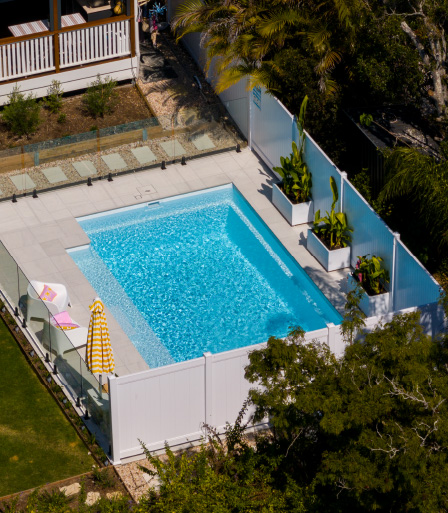
3. Regularly Checking Pool Equipment
Fibreglass pools rely on various equipment to keep the water clean, clear, and safe to swim in. Regular inspection and maintenance of the pool’s equipment are essential to ensure everything is functioning properly.
- Pool Pump and Filter: The pool pump circulates water through the filter, which removes debris and particles from the water. Check the pool pump and filter regularly for any clogs or signs of wear and tear. A clogged filter can reduce water circulation and cause strain on the pump, potentially leading to expensive repairs. Depending on the size of the pool, the filter should be cleaned every few weeks during peak swimming seasons. Be sure to replace the filter as recommended by the manufacturer.
- Saltwater System: If you have a saltwater pool, it’s important to check the salt chlorinator system regularly. Saltwater systems generate chlorine through electrolysis, which keeps the water disinfected. Over time, calcium deposits can build up on the salt cell, reducing its efficiency. Clean the salt cell as per the manufacturer’s instructions to ensure the system is working effectively.
- Pool Heater: If your fibreglass pool has a heating system, ensure that it’s serviced regularly to keep it running efficiently. Pool heaters can wear out over time due to constant use, and regular maintenance will help extend their lifespan.
4. Managing Pool Water Level
The water level in your pool should always be maintained at the correct level. If the water level is too low, the skimmer might run dry, which can cause the pump to burn out. On the other hand, if the water level is too high, debris may not be properly skimmed from the surface, and the pool may become difficult to clean.
During the summer, evaporation can lower the water level, so it’s essential to top up the pool regularly to ensure it remains within the recommended range. If your area experiences a lot of rain, you may need to remove excess water using a submersible pump to avoid overfilling.
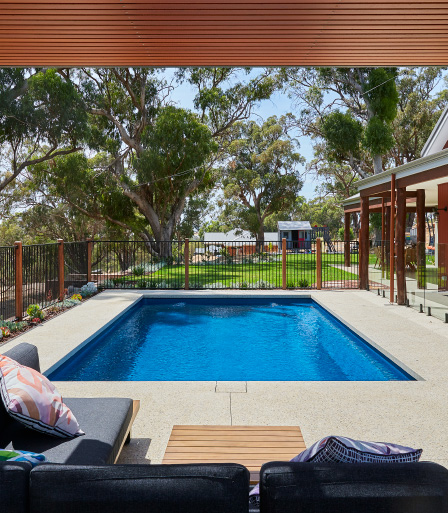
5. Protecting the Pool from the Elements
While fibreglass pools are durable and weather-resistant, extreme weather conditions can still affect their appearance and functionality. Protecting your pool from harsh elements is crucial for maintaining its longevity.
- Sun Exposure: Excessive exposure to the sun can cause the pool water to heat up, which can lead to algae growth and increase the need for chemicals. Consider installing a pool cover or shade sail to protect the water from direct sunlight when not in use. A pool cover also helps keep the water cleaner by preventing debris from falling in.
- Rain and Wind: Storms, heavy rain, and strong winds can introduce a significant amount of debris into your pool. After a storm, it’s a good idea to clean the pool thoroughly and check the water chemistry.
- Pool Covers: A pool cover is also beneficial during the winter months or when the pool is not in use for extended periods. It helps reduce debris and prevents your pool from becoming a breeding ground for insects.
6. Repairs and Maintenance
Though fibreglass pools are relatively low maintenance, they can still require repairs over time. Common issues include small cracks or chips in the pool surface, which can occur due to accidental damage or wear. These can usually be repaired by a professional with a fibreglass repair kit.
It’s important to address any repairs promptly to avoid more significant damage. If you notice any issues with the pool surface, such as cracks or peeling, it’s best to contact a pool professional for advice on how to proceed with repairs.
Caring for your fibreglass pool involves regular cleaning, maintaining water quality, inspecting pool equipment, and ensuring the pool is protected from the elements. By following these maintenance tips and staying on top of your pool’s condition, you can enjoy a beautiful and functional pool for years to come. Regular care not only enhances the swimming experience but also helps preserve the longevity of your investment, ensuring that your fibreglass pool remains a source of enjoyment for your family.